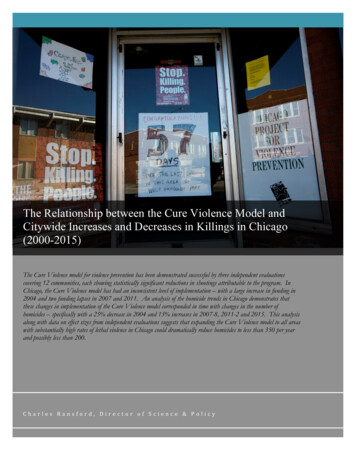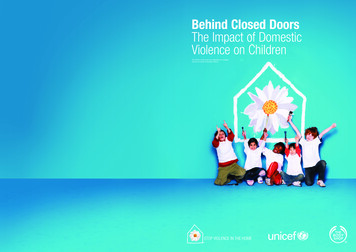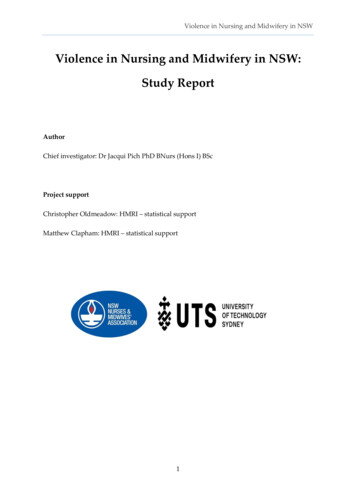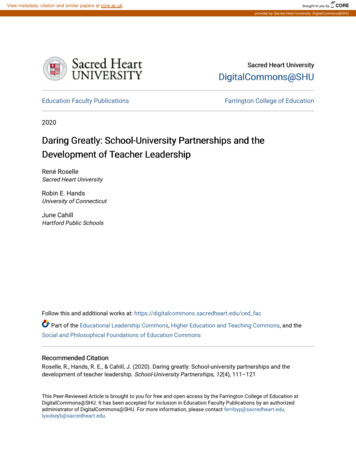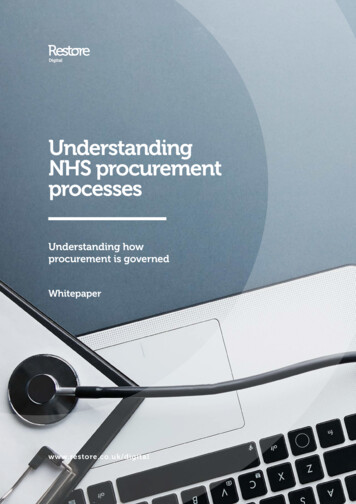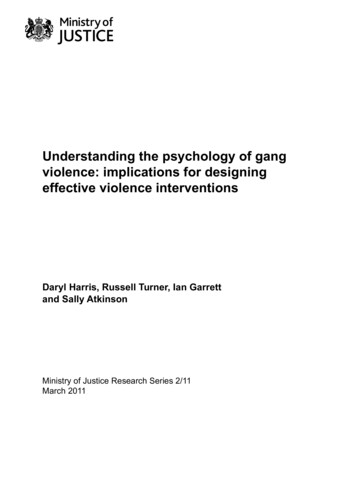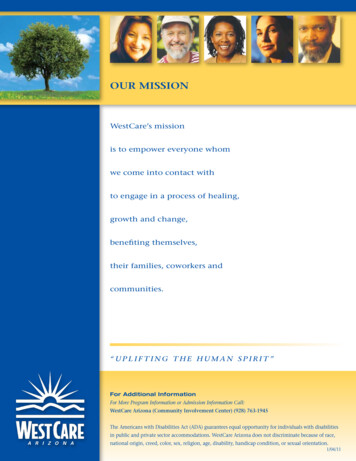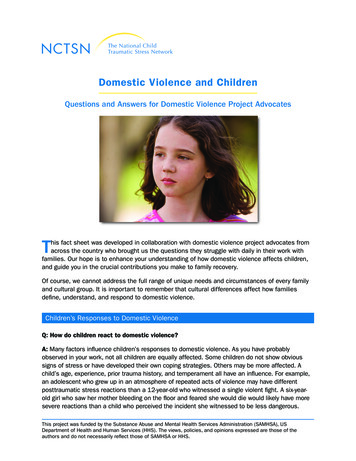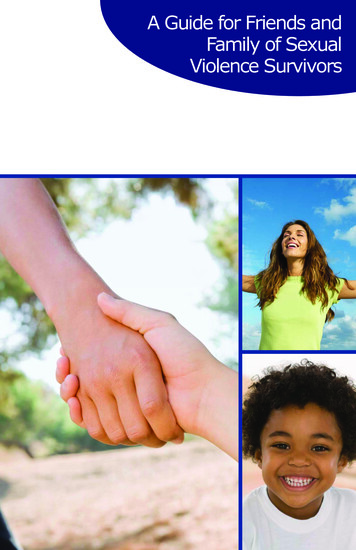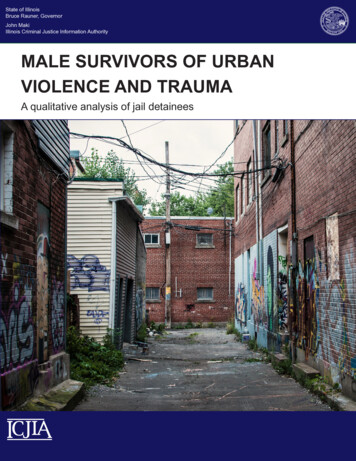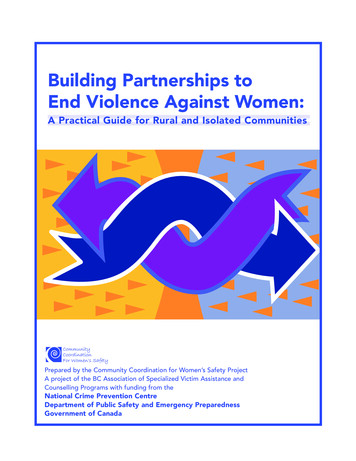
Transcription
Building Partnerships toEnd Violence Against Women:A Practical Guide for Rural and Isolated CommunitiesPrepared by the Community Coordination for Women’s Safety ProjectA project of the BC Association of Specialized Victim Assistance andCounselling Programs with funding from theNational Crime Prevention CentreDepartment of Public Safety and Emergency PreparednessGovernment of Canada
Copyright 2005BC Association of Specialized Victim Assistance and Counselling Programs728-602 West Hastings StreetVancouver, BC, Canada V6B 1P2Phone: 604-633-2506Fax: 604-633-2507Email: bcasvacp@endingviolence.orgWebsite: www.endingviolence.orgThis guide was created collaboratively by the Community Coordination forWomen’s Safety Project Team (a project of the BC Association of SpecializedVictim Assistance and Counselling Programs): Morgen Baldwin, GailEdinger, Sarah Leavitt, Tracy Porteous and Gisela Ruebsaat.This project was funded in part through the Government of Canada’sNational Crime Prevention Strategy.Layout and design: Britt Permien
AcknowledgementsThis guide could not have been written without the generous participationof workers across BC who are involved in partnerships to end violenceagainst women. Great thanks is also given to the Ministry of Public Safetyand Solicitor General, specifically, Jane Coombe, Linda Light and SusanneDahlin in the Victim Services and Community Programs Division, for theircollaboration on the funding proposal and their foundational document,Community Coordination to Stop Violence Against Women Framework.Thank you to all of those listed below for sharing your wisdom and experience:MEMBERS OF THE PARTNERSHIPS THAT WE INTERVIEWED FOR THIS GUIDEThe Abbotsford/Mission Violence Against Women CoordinatingCommittee(Interviewees: Teri McLennan, Coordinator, Abbotsford Transition Houseand chair of the committee; and Pam Dimond, Coordinator, AbbotsfordPolice Victim Assistance, and member of the committee)North Shore Women in Crisis, a partnership between FamilyServices of the North Shore and the RCMP(Interviewees: Laurie Kohl, STV Counsellor/Coordinator, Family Services ofthe North Shore; and Linda Thorp, Coordinator, RCMP CrisisIntervention Unit)Vancouver Police Department Domestic Violence & CriminalHarassment Unit (DVU)(Interviewees: Nick Phillips, former Manager, Relationship Safety Project,Family Services of Greater Vancouver; Marnie Stickley, CommunityCounsellor, DVU; Keith Hammond, Sergeant in Charge of DVU; andDoug LePard, Deputy Chief, CMND Investigation Division and formerSergeant in Charge of the DVU)A partnership between the Princeton RCMP, RCMP Victim Servicesand Citizens on Patrol(Interviewees: Staff Sergeant Warren Dosko, Detachment Commander of thePrinceton RCMP; and Rosemary Doughty, Manager of RCMP VictimServices and Coordinator of Cindy Parolin Safe Homes Program)The Victoria Violence Against Women in RelationshipsCoordination Committee(Interviewees: Wendy Walsh and Elaine Morton, Co-chairs)The CCWS Project (producer of this guide), a partnership betweenthe BC Association of Specialized Victim Assistance andCounselling Programs (BCASVACP) and the Victim Services andCommunity Programs Division (VSCPD) of the Ministry of PublicSafety and Solicitor General(Interviewees: Tracy Porteous, Executive Director, BCASVACP; and JaneCoombe, Policy and Program Analyst, VSCPD)2
The Massett Safer Communities: Everyone’s Responsibility Committee(Interviewee: Sergeant Rick Shaw, Committee Organizer/Member, RCMP Massett)A Partnership between Saltspring Women Opposed to Violence andAbuse (SWOVA), and School District 64 (Gulf Islands)(Interviewees: Lynda Laushway, Project Coordinator, SWOVA;and Wendy Herbert, Superintendent, SD 64)The Prince George Victim Support Services Committee(Interviewees: Bally Bassi, Social and Justice Services Manager, Elizabeth FrySociety; and Natashia Bacchus, Program Coordinator, RCMP Victim Services)The Men’s Treatment Program at MOSAIC in Vancouver(Interviewees: Ninu Kang, Director of Family Programs and men’s treatmentgroup co-facilitator)The Boundary Family Violence Prevention and Intervention Committee(Interviewees: Kathy O’Malley, Project Coordinator, New Rural PartnershipsProject)The Cowichan Valley Regional District Safety Advisory Committee(Interviewees: Terri Dame, Supervisor)The Dawson Creek Violence Against Women in Relationships Committee(Interviewees: Bill Jackson, Crown Counsel, Dawson Creek)EXTERNAL READERSA group of external readers reviewed an early draft of the guide; theirinput and comments have been included throughout the guide in areaswhere they brought essential expertise to this document. The readers are:Corporal Robin Bridge, RCMP “E” Division; Monika Chappell, DisAbledWomen’s Network (DAWN) Canada; Jane Coombe, MPSSG; Sheila Dick,Counsellor/Family Support Worker, Canim Lake Band; Pam Gregg, cochair of the Vanderhoof Violence Against Women in RelationshipsCoordination Committee; Ninu Kang, MOSAIC; Michelle Novakowski,chair of the Nanaimo Violence Against Women in RelationshipsCommittee; Anita Pascoe of Pacific Association of First Nations Womenand Nancy Taylor, co-chair of the Robson Valley CommunityCoordination for Women’s Safety Committee.PROJECT FUNDERSWe are grateful to the National Crime Prevention Centre, Department ofPublic Safety and Emergency Preparedness, Government of Canada, for providing the funding for this project—The Partnership as a Primary Tool inCommunity Coordination for Women’s Safety. We would particularly like tothank Vera Lagasse, Director BC Region, for her ongoing enthusiastic support.3
WORKING GROUP OF THE COMMUNITY COORDINATION FOR WOMEN’SSAFETY PROJECTCurrent members of the CCWS Working Group are: Shashi Assanand,Executive Director, Vancouver and Lower Mainland Family SupportServices; Simon Barton, Program and Policy Analyst, Ministry ofCommunity, Aboriginal and Women’s Services; Corporal Robin Bridge,RCMP “E” Division; Deputy Chief Constable Mike Chadwick, SaanichPolice Department and BC Chiefs of Municipal Police; Jane Coombe,MPSSG; Ninu Kang, MOSAIC; Inspector Richard Konarski, Surrey RCMP;Vera Lagasse, National Crime Prevention Centre; Kamaljit Lehal, lawyer;Chief Superintendent Al Macintyre, RCMP “E” Division; Forrest Nelson,Legal Services Society; Staff Sergeant Doug Oakley, Saanich PoliceDepartment; Anita Pascoe, Pacific Association of First Nations Women;Kirsten Peters, Community Corrections; Shelley Rivkin, Director, Centrefor Leadership and Community Learning, Justice Institute of BC; KarenStone, Executive Director, BC/Yukon Society of Transition Houses; andDiane Turner, lawyer.EVALUATORThanks to Diana Ellis for her evaluation of the early stages of this project.4
Table ofContents1 BACKGROUND AND HISTORY091.1 The Community Coordination for Women’s Safety Project091.2 Partnership and Community Coordination102 VIOLENCE AGAINST WOMEN ANDTHE BENEFITS OF PARTNERSHIP132.1 Violence Against Women in Canada132.2 Addressing the Fragmented Response152.2.1 What is a “Fragmented Response”?152.2.2 The Impact of Fragmentation162.3 The Benefits of Partnership172.3.1 What Do We Mean By Partnership?172.3.2 What Do Partnerships Offer to Partners?192.3.3 How Do Partnerships Increase Women’s Safety?202.3.4 The Impact that Partnerships Have Had onWomen’s Safety in BC Communities21Table of Contents5
3 INTRODUCTION TO THE GUIDE243.1 How to Use the Guide243.2 Why Did We Write This Guide?243.2.1 Communities Across BC Have Shown That Partnerships Work243.2.2 We Need to Balance Resistance and Reorganization253.2.3 Partnerships Need Practical Tools263.3 Who Is This Guide For?273.4 How Did We Write This Guide?273.4.1 The Partnership Project273.4.2 The Initial Interviews283.4.3 Further Research323.5 A Note About Language324 THE ELEMENTS OF A SUCCESSFUL PARTNERSHIP354.1 The Importance of Building Relationships354.2 Let’s Get Philosophical: Finding Common Ground374.2.1 Violence Against Women Is A Philosophical Issue384.2.2 Is It Important to Have Shared Philosophy?394.2.3 Some Common Philosophical Differences404.2.4 Tips for Finding Common Ground414.2.5 The Importance of Written Agreements/Records464.3 Leadership, Vision and Commitment484.4 Who Does What:Clarifying Mandates, Roles and Responsibilities494.4.1 Mandates494.4.2 Roles and Responsibilities504.4.3 Tips for Clarifying Mandates, Roles and Responsibilities504.5 Supporting Best Practices and Policies534.6 Talky-talky vs. Worky-worky: Balancing Task and Process554.6.1 What Does This Mean?554.6.2 Some Common Examples55Table of Contents6
4.6.3 Tips For Balancing Task and Process554.7 Confidentiality and Safety604.7.1 The Conflict Between Safety and Confidentiality604.7.2 Tips for Balancing Confidentiality and Safety624.8 Information Sharing664.8.1 Information Sharing Within the Partnership664.8.2 Information Sharing Related to the Partnership674.8.3 Tips on Information Sharing674.9 Power Imbalances684.9.1 How Do Imbalances Develop?684.9.2 Tips for Addressing Power Imbalances704.10 Diversity724.10.1 Tips for Encouraging Diversity754.11 Accountability794.11.1 What Do We Mean By Accountability?794.11.2 Tips for Ensuring Accountability794.12 Knowing When to Dissolve the Partnership824.12.1 Tips for Successfully Dissolving a Partnership835 CHALLENGES AND SUCCESSES845.1 Challenges to Watch For845.1.1 External Challenges845.1.2 Tips for Responding to External Challenges855.1.3 nternal Challenges885.1.4 Tips for Responding to Internal Challenges905.2 Creative Practice925.3 Some Final Tips for Success94Table of Contents7
6 THE PARTNERSHIP TOOLKIT966.1 Solutions Management Exercise976.2 Mission Statement Building Exercise996.3 Sample Mission Statement and Objectives1016.4 Sample Partnership Agreement1026.5 Sample Memorandum of Agreement1106.6 On Finding Common Ground1126.7 Group Development Exercise - Addressing Stereotyping1146.8 Sample Philosophical Agreement1156.9 Quiz: Do You Have a Partnership Positive Perspective?1166.10 List of Common Acronyms1176.11 Dimensions of Diversity:Values, Beliefs and Power Imbalances1197 APPENDIX1217.1 Inspirations for Coordination: Jurisdictions That Led the Way1227.2 Findings on the Importance of Coordination from Researchand Coroners’ Inquests1247.3 Bibliography128Table of Contents8
1. BACKGROUND AND HISTORY1.1 The Community Coordination for Women’sSafety ProjectCommunity Coordination for Women’s Safety (CCWS) Project isan outcome of the work of local and provincial women’s organizations and of the Victim Services and Community Programs Division(VSCPD) of the Ministry of Public Safety and Solicitor General (MPSSG).The project began in 2001 as the result of several years of consultation andcoordination that the MPSSG and BC Association of Specialized VictimAssistance and Counselling Programs (BCASVACP) has been doing withgroups across the province who are attempting to improve their communities’ response to violence against women.TheThe CCWS Project was designed to help rural and isolated communitiesenhance intersectoral coordinated responses to violence against women, witha particular focus on women who experience specific barriers to accessingintervention and support services (including Aboriginal women, women ofcolour, immigrant women, low-income women, women with disabilities,lesbians, transgender women, older women and young women).CCWS Project Goals and ObjectivesVision:To increase the safety of assaulted women in rural and isolated communitiesin BC.Goal:To help rural and isolated communities develop new, and enhance existing,intersectoral coordinated responses to violence against women.Objectives:1. To provide support to rural and isolated communities for the implementation of intersectoral violence against women policies and successful practices.2. To assist rural and isolated communities to address and remove barriers thatlimit women’s access to the justice system and other relevant response systems for women who face particular discrimination.3. To facilitate the development of an effective and consistent communityresponse that enhances assaulted women’s access to the justice and otherrelevant systems.4. To increase a rural and isolated community’s ability to analyze issues relatedto women’s safety.5. To support the development of solutions and strategies at the local, regionaland provincial levels that address assaulted women’s access to the justicesystem and other relevant response systems.6. To assist rural and isolated communities to identify and bring forward issuesthat need to be solved at the provincial level.7. To analyze and problem solve identified local, regional and provincial issuesusing a range of initiatives chosen to effect change.1. Background & History9;
The project’s development and start-up work was managed through a partnership between the BCASVACP and VSCPD. Approximately nine monthsafter the intensive work of project start-up, the BCASVACP took over as thesole managing partner, while VSCPD continued to participate actively in theWorking Group. Funding for the CCWS Project has been provided by abroad spectrum of sources, namely, the Law Foundation of BC; the NationalCrime Prevention Centre Community Mobilization Program and CrimePrevention Partnership Program (Justice Canada); the National VictimsPolicy Centre of the Federal Department of Justice; the Ministry ofCommunity, Aboriginal and Women’s Services; and the Ministry of PublicSafety and Solicitor General. The Law Foundation of BC was the major funder for the first 2.5 years of the project.1.2 Partnership and Community CoordinationMarch of 2002, the National Crime Prevention Centre PartnershipProgram agreed to fund an extension to the CCWS Project—ThePartnership as a Primary Tool in Community Coordination for Women’sSafety Project—so that we could study and document the aspects of partnership that actively contribute to women’s safety, and produce a guide thatwould share these models of effective partnerships (see section 3.4, How DidWe Write This Guide? for more information). This funding has allowed theCCWS Project to explore the strong connection between partnership and community coordination to improve women’s safety. Linda Light, in Working Together toRespond to Sexual Assault, describes the connection in this way: “Coordinationcan be one of the potential outcomes of collaborative partnerships.”InSince 1989, community organizations and the Victim Services andCommunity Programs Division of the Ministry of Attorney General (nowthe Ministry of Public Safety and Solicitor General) have been involved inthe development of Violence Against Women Coordination Initiatives in BC.These initiatives bring system-based and community-based representativestogether to enhance collaboration on local responses to violence againstwomen. In 1989, the Ministry of Attorney General funded seven CommunityCoordination Initiatives, modeled on coordination projects in Victoria, BC,and London, Ontario, and on the Duluth Domestic Abuse Intervention program (see Appendix for more information on these two projects). Since thattime, more initiatives have been started across the province, although since2002 none has been funded by the provincial government. Currently thereare Coordination Initiatives in over fifty communities across BC, many ofthem in rural and isolated areas (a complete list of these initiatives is available at www.endingviolence.org).The fact that coordination activities related to violence against women hadbeen going on in BC communities and systems for over 20 years was animportant and positive foundation for the CCWS Project. For example:1. Background & History10
Since 1989, coordination in BC has been consideredan essential part of implementing the Ministry ofAttorney General’s policy on Violence Against Womenin Relationships. The original partnership with VSCPD was a particular fac-tor in the overall success of the project, as the VSCPDbrought and shared extensive links with colleagues in thesystem, specifically police and corrections. VSCPD alsobrought their extensive knowledge from their experience ofsupporting local Coordination Committees and managing150 victim services programs. From 1989 until 2002, VSCPD’s dedicated policy analystmanaged the funded coordination programs in theprovince, tracked issues raised in the field that related topolicy implementation and worked across ministries forinstitutional reform. The BCASVACP, with its ten-year history of supportingand building coordination in the field, brought a provincewide network of 150 anti-violence programs and its owngood reputation for substantive work on coordination andbuilding partnerships.eCoordinationin Action BC has also benef ited from the existence of otherprovincial organizations who have also been working collaboratively specif ically in the area of violence againstwomen. Just to name a few: The BC Institute AgainstFamily Violence, BC and Yukon Society of TransitionHouses, Ending Relationship Abuse Society of BC, BCCoalition of Women’s Centres, Legal Education ActionFund, BC Women’s Hospital and Cowichan Valley SaferFutures Program.“With the Domestic Violence Unit wewanted to embody the principles ofcoordination and the conversationthat had been occurring over severalyears—embody that in a service. Andembody it in a service that wouldaddress the post-arrest, post-chargeperiod, highly dangerous for womenand really underserved. And the ideaof the partnership was to have reallyfunctional coordination, police andsocial services working together, andactually having to sort it out on theground, sort out what the responsewould be and not just talk about itand have it start crashing.” —Doug LePard, former Sergeant inCharge of DVU, Vancouver CCWS Project staff who were hired brought a total ofmore than 75 years of “on the ground” experience in violence against women coordination, as well as considerableexpertise in coordination research, management, educationand resource development. Coordination tools previously developed by VSCPD andothers were expanded and adapted by project team. Even though government had stopped funding the sixcommunities in BC that had core funding for coordinationwork, most of them continued to work in a coordinatedmanner. Their presence provided a basis for further workby CCWS project team. (These communities were DawsonCreek, Campbell River, Courtenay/ Comox, Nelson,Vancouver and Williams Lake.)1. Background & History11
The work of the CCWS Project has been grounded in theevidence-based research and the experience of other communities in Canada and the United States, where coordination among law enforcement and community serviceproviders has proven to be one of the most effective methods of increasing women’s safety. Communities with acoordinated response are more likely than other communities to have more effective referral systems, a better understanding of mutual roles and responsibilities and a moreefficient use of resources. In this guide, we use “coordination” to mean coordina-tion of a community’s response to violence againstwomen through the building of a series of collaborativepartnerships among responders. For us, “coordination” isan active word that describes the outcome (a more coordinated response), not the tool to achieve this (workingin partnership).;1. Background & History12
2. VIOLENCE AGAINST WOMEN ANDTHE BENEFITS OF PARTNERSHIP2.1 Violence Against Women in Canadayou are reading this guide, you are probably aware that violenceagainst women is a serious problem in Canada. For the last 50 yearsfeminists have been working tirelessly to raise public awareness of these issuesand have been working towards law reform, the development of public policy and legislation and programs that can more effectively respond to whathistorically was seen as a private matter. Much has changed and we havewomen to thank for the advancements. However, the statistics tell the storythat violence against women remains a serious social issue that still needs ourfocus and attention. (It is important to note that while statistics are useful,they are generally lower than the actual rate of violence, due to underreporting of crimes such as violence in relationships and sexual assault.)If 30% of women currently or previously married have experi-enced at least one incident of physical or sexual violence atthe hands of a marital partner (Family Violence in Canada: AStatistical Profile, Statistics Canada, 1999). 12% of young women, aged 18 to 24, reported at least oneincident of violence by a marital partner in a one-year period— 4 times the national average (Family Violence in Canada:A Statistical Profile, Statistics Canada, 1999). In BC, three out of ten Level 1 assaults (assaults not involvinga weapon or resulting in “serious” physical injury) are spousalassaults. In almost half the incidents the assault takes place inthe victim’s home, the accused’s home, or a home shared byboth (Police and Crime, Summary Statistics, 1991-2000, PoliceServices, Ministry of Public Safety and Solicitor General). In 2000, a total of 4,100 sexual assaults and other sexualoffences were reported in British Columbia. 87% were classified as level 1 sexual assaults, whereas 2% were level 2 sexual assaults and 1% was level 3 sexual assaults. Another10% were other types of sexual offences, such as sexualtouching or interference, sexual exploitation and incest(Police and Crime, Summary Statistics, 1991-2000, PoliceServices, Ministry of Public Safety and Solicitor General). In 2000, the majority (54%) of female victims of sexualassault were under age 18 (20% were under age 12 and 34%were from 12 to 17 years old). Adult women aged 18 andover accounted for 45% of the female victims (CanadianCrime Statistics 2000 — Catalogue no. 85-205, CanadianCentre for Justice Statistics, Statistics Canada, 2001).2. Violence Against Women and the Benefits of Partnership13
According to the 1999 General Social Survey, Aboriginal peo-ple were more likely than other Canadians to report beingassaulted by a spouse in a five-year period. Approximately 20%of Aboriginal people reported being assaulted by a spouse ascompared with 7% of the non-Aboriginal population (The 1999General Social Survey on Spousal Violence, Statistics Canada, 2000). Immigrant and refugee girls experience higher rates of vio-lence because of dislocation, racism, and sexism from bothwithin their own communities and the external society(Violence Prevention and the Girl Child, Yasmin Jiwani et al,The Alliance of Five Research Centres on Violence, 1999). 51.1 percent of all women with disabilities experience sexualabuse, 50.8 percent experience physical abuse, and 52.3 percent experience three or more forms of abuse (Don’t Tell Meto Take a Hot Bath, Shirley Masuda, DAWN Canada, 1995). Women who have experienced family violence are at greaterrisk for alcohol and other drug problems than those whohave not (Fact Sheet on Family Violence and Substance Abuse,National Clearinghouse on Family Violence, 1993).For many women, the experience of violence is connected to other barriersthat they face, including racism, poverty, ableism, homophobia, and geographical isolation. All these forms of oppression create significant barriersto women obtaining help when they have been abused.“Women, particularly those from immigrant andAboriginal communities, may get caught betweenthe response from their own family and community,and that of the local responders. Their choiceto access response services may mean alienationfrom their own family and/or community. —Ninu Kang, Director of Family Programs andmen’s treatment group co-facilitator,MOSAIC, Vancouver”There may also be barriers within particular marginalized communities. TheOur Women Our Strength (OWOS) program works to address some of thebarriers within BC Aboriginal communities that have resulted from the history of colonization and oppression of these communities.“It is extremely difficult for women in rural/isolatedFirst Nations communities to reach out — not justbecause of a fear of retaliation, but because of a lackof safe support systems in the community (no confidentiality), lack of trust (of anyone outside of theirfamily), inter-family and inter-community politics, etc.—Anita Pascoe, Pacific Association ofFirst Nations Women”2. Violence Against Women and the Benefits of Partnership14
In recent years, a trend towards social and fiscal restraint, and an overallsocial trend toward focusing on economic issues at the expense of socialissues in general, has resulted in cuts to services that relate to violence againstwomen, such as: sexual assault centres, Violence Against WomenCoordination Committees, women’s centres, assaultive men’s treatment programs, court houses, legal services; and changes to related policy and legislation. These cuts and changes have made it even more difficult for abusedwomen to find safety and support.2.2 Addressing the Fragmented Response2.2.1 What Is a “Fragmented Response?”There are many services that respond to violence against women, including community-based victim services, transition houses, Aboriginal organizations,assaultive men’s treatment programs, police based victim services, tribal councilsand faith organizations, police, child protection, hospitals, probation, social assistance, etc. A woman who has been abused comes into contact with theseresponse services in a number of possible ways. She may involuntarily becomeinvolved with police or child protection due to reports by a third party. She mayseek help herself from a hospital, a community-based agency or the legal system.When a survivor of violence comes in contact with community-based or systemsbased services, if those services do not have a coordinated response in place, thesurvivor can encounter gaps in service or lack of coordination of services thatmay seriously compromise her safety. This is what we mean by a fragmentedresponse. Her community-based support worker may not have the working relationship with police that would help the woman gain the protection she needs;police may not refer women to appropriate community-based services due to lackof information or awareness, or policies that create barriers to a seamless service.Offenders can also encounter gaps. These gaps can include a lack of voluntary and mandated treatment programs, lack of consistent enforcement ofcourt orders, and sentencing to anger management or mental health counselling instead of treatment that addresses issues of power and control.Beliefs and attitudes can also contribute to fragmentation of services.Sometimes service providers may struggle to work collaboratively because ofhistoric judgments or beliefs or lack of information about colleagues in otherdisciplines or other areas of difference such as race, gender, class and ability.“Police or community-based agencies may nothave information about nor awareness of theparticular barriers faced by marginalizedgroups, such as the relative lack of accessibleresources for women with disabilities, if theyhave no partnerships that bring disabilityawareness to the table. —Monika Chappell, DisAbled Women’s Network(DAWN) Canada2. Violence Against Women and the Benefits of Partnership”15
2.2.2 The Impact of FragmentationWomen who are accessing services know when services are working well andcan experience the direct benefits of this; they also know first hand whencollaboration is not happening. A recent BC study confirmed that womenwho had experienced violence and sought help were well aware of how coordinated the response was. Measures of Empowerment for Women Who are Victimsof Violence and Who Use the Justice System by Mary Russell, quotes one victimwho stated, “‘The police, Crown and Probation all worked together andtalked to each other in fixing the no-contact order.’” Russell continues,“In contrast, victims were also aware when theservice they received was from an isolated unit[non-coordinated] perspective. For example,one victim who felt that she had been ill-served,that there was little sharing of informationbetween services, described her experience asfollows: “There was no team work becauseeach is an individual organization, and you arejust left hanging there.””Survivors of abuse usually struggle with a great deal of shame and self-blame:the offenders tell them that they have somehow caused the abuse and manysocietal attitudes confirm this accusation. Many survivors suffer from post-traumatic stress and physical injuries or serious long-term effects on their health.Most women who are in abusive relationships want the violence to stop, butdo not necessarily want the relationship to end. However, community andsystem based responders as well as the general public often focus on thewoman leaving as the solution to the violence. Women who do leave an abusive relationship may try several times (on an average five to eight times)before leaving for good. The services a woman is able to access during thesetrial attempts at safety will have everything to do with whether she feels safety is possible.In addition to these factors, there is the fact that many survivors of abuse arestill not safe after they leave their relationship: the abuse often continues oreven escalates once a survivor leaves. (Forty percent of women with a violentex-partner reported that violence occurred after the couple separated, andmost of them stated that the assaults became more severe or began after separation [Statistics Canada Juristat, Vol 21 No 7, 2001]). It is common for awoman who has been abused to live with a high level of justified fear due toongoing violence and/or threats of violence. In a small isolated community,a woman may be at additional risk where there is a concerted effort on thepart of community leaders to deny or minimize the incidence of violence, orwhere people who speak out about violence are threatened or assaulted.When a survivor falls through the gaps created by
Great thanks is also given to the Ministry of Public Safety and Solicitor General, specifically, Jane Coombe, Linda Light and Susanne . Counsellor, DVU; Keith Hammond, Sergeant in Charge of DVU; and Doug LePard, Deputy Chief, CMND Investigation Division and former . Thanks to Diana Ellis for her evaluation of the early stages of this .
